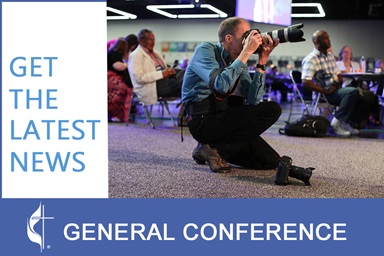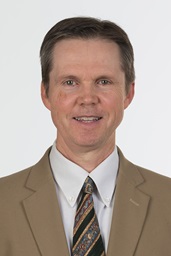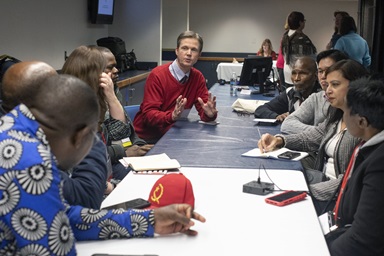Ruth Schwab will grieve on April 19, but the United Methodist who survived the bombing of the Alfred P. Murrah Federal Building 20 years ago that day will also be grateful.
She reached that place of gratitude with the help of God, her church and many others.
A member of First United Methodist Church in Oklahoma City, Schwab was at her desk in the federal building at 9:02 that morning in 1995. A homemade bomb concealed in the bed of a Ryder truck detonated in what — until Sept. 11, 2001 — was the deadliest act of terrorism that had ever occurred on American soil. Altogether, 168 people — including 19 children — died and more than 500 were injured.
Timothy McVeigh, who parked the bomb-laden truck, and Terry Nichols were later convicted of building the bomb and organizing the attack.
Then 46, Schwab was the single mother of five. The oldest was away at college, and the others — ages 9, 11, 13 and 15 — lived with her. For 23 years, she had worked at the U.S. Department of Housing and Urban Development.
“Suddenly, there was a tremendous boom. Then it seemed like I was being hurled down a dark, black hole,” Schwab says.
The floors of the nine-story building were caving in on top of one another.
Schwab regained consciousness on the floor, bleeding profusely from cuts, especially to her face, neck and arms. She was pelted by shards of glass that slashed both of her eyes.
Suffering continues after bombing
It’s been two decades since the bombing of the federal building, but hundreds of people still suffer from the horrors they experienced on April 19, 1995.
The Rev. Michael Potts — a United Methodist minister and licensed professional counselor who was called in by the American Red Cross hours after the bombing — is still engaged in ministry to those whose lives were damaged by the bombing.
“Some people still have physical injuries,” Potts says. “Just a few days ago, a woman’s face finally healed to the point that doctors could replace an ear she lost in the bombing.”
Potts initially debriefed workers who risked their lives going into the wreckage of the building to rescue the injured and remove the dead.
Most people he now sees are suffering from post-traumatic stress sidebar. Some of those are first-responders, others are spouses and children of those who died or were badly disabled.
“Many are going through retirement or some other life transition. Others have been relying on alcohol or some other substance to deny or deaden their pain. And it hasn’t worked,” he said.
Potts says both as a consultant for the Red Cross and as a counselor in his psychotherapy practice, he has seen evidence to support lessons that are often forgotten.
He offers these examples:
- Any trauma — especially one that is life threatening — is life changing. “When you face your own mortality, you realize how fragile life is. You are likely to shift your expectations and reorient your priorities. Your identity is changed.”
- Our feelings need healing, just like our bodies do. “Different individuals have different feelings and different ways of responding to feelings. Feelings that we deny or bury sometimes resurface years later.”
- “We learned that people who are grieving need a safe place that respects them, that doesn't try to give them all the answers, but helps them find their answers, a place that gives them time to heal, where they can experience a source of healing that can make them whole again. Our churches are called to be such a safe place.”
The Rev. Guy Ames — senior pastor of Chapel Hill United Methodist Church in Oklahoma City at the time of the bombing, and a former national consultant for the United Methodist Committee on Relief — agrees that many people are still suffering from the bombing.
Ames points out that in addition to the Murrah Federal Building, 324 other buildings were damaged or destroyed within a 16-block radius. He estimates that in addition to the 168 killed in the bombing, at least 2,500 were physically injured. He suspects hundreds of them are still hurting.
"One lesson we learned, is that we need to provide more emotional and spiritual care to our rescue and recovery workers, to our ministers and other caregivers, to people who had lived in nearby apartments that were damaged, and to people who owned and worked in the hundreds of business in the area who suffered heavy financial losses,” Ames said.
The number one thing Ames says he learned from the bombing was that man-made disasters could happen even in America's heartland.
The Rev. David Wilson, superintendent of the Oklahoma Indian Missionary Conference, says the bombing of the Murrah Building also taught conference leaders that they needed to be better prepared for disasters.
“We can never prepare enough for everything that might happen, but we must prepare the best we can before disasters strike,” Wilson says.
Since the bombing, the conference developed some of the most effective Native American disaster-response teams in the country.
‘Is anybody there?’
“I couldn't see anything. It was a blessing in a way. I was spared from seeing lots of gruesome sights,” she says.
“I hollered, ‘Is anybody there?’ Then the sweetest voice I’d ever heard answered back. ‘I'm here, Ruthie. I'm coming to you. Don’t move.’ It was my co-worker, V.Z. Lawton. We inched our way through the debris. Before we got far, things we couldn’t move or get around blocked us. In a few minutes, rescue workers made it to us and carried us out of out of the building.”
Schwab was rushed to a hospital. After eight hours of surgery, specialists had some hope for saving her left eye, but not her right.
Three days later, she went home just in time for her 47th birthday — a day that brought a special reason to celebrate.
"I was telling my kids about my friends who were killed in the building. Evidently, the swelling in my left eye had gone down a little. All of a sudden, I could see something. It looked like polka dots. In a few seconds, my vision cleared some more, and I could tell I was seeing flowers and ‘happy birthday’ balloons all over the room. I knew I was going to see again.”
Specialists later replaced her right eye with a newly developed prosthetic eye.
During the next few months, Schwab had several more surgeries to repair her jaw and remove scars caused by cuts that had required more than 200 stitches.
Losses kept adding up
Physical pain wasn’t all Schwab had to cope with. As the months passed, she became increasingly aware of what she had lost.
She had lost her right eye, and she could never get it back. She had lost a job she loved, and the paycheck she depended on. She had lost scores of friends who worked at HUD and in other offices — one of them was one of her “closest buddies,” Patricia Nix.
“Pat kept a box on her desk that looked like a loaf of bread and was filled with Scripture readings on little slips of paper. Friends would come by and tell Pat what was troubling them. She would hand them her little box and invite them to pull out a scripture. They would read it. Pat would tell them, ‘Just wait; God's going to fix it. Just trust him.’ And they would say thanks and walk away.”
Schwab says she felt overwhelmed, helpless and angry.
“I walked through my house, yelling. ‘Timothy McVeigh, I hate you! Why did you blow up our building and kill so many innocent people and leave so many of us messed up for the rest of our lives! I didn’t do anything to you. Why did you do this to me?”
And she was angry with God.
“Nothing made sense,” she says. “Why did God let McVeigh do this? Why did God take Pat, who was such a loving and faithful Christian? Why had he left me and taken her? Why?”
She felt guilty for surviving. Guilt, grief, anger and hate were making her bitter.
“I tried, but for a long time, I couldn't forgive.”
Ministering to survivors continues
The Rev. Michael Potts, a United Methodist clergyman who is a licensed professional counselor, says Schwab is not alone in her struggles. Finding healing can take a long time for people hurt in such a traumatic event, he said.
Potts, who helped in 1995 and is still helping survivors, says such a life-threatening situation becomes part of who you are and who you become.
“When you are overwhelmed by destructive feelings that you can do nothing about, such as fear and anger and being unable to forgive, it makes a tremendous difference if you have faith in a power greater than yourself who can enable you to get through them and grow stronger.”
Finally, forgiveness
Schwab’s feelings finally passed.
What released Schwab from her fear and anger and freed her to hope and love again? What enabled her to forgive?
She has no doubts.
“God pulled me through!” she declares. “God saved me physically, emotionally and spiritually. That’s the only way I can explain it!”
She says God worked through rescue workers and medical professionals who saved her life; through her family and friends, who stood by her, eager to help any way they could; through a Christian counselor, who helped her and her children get through troublesome emotional issues; and through countless people who prayed for her.
And Schwab says God worked through her church, which embraced her with love, giving her a safe place to grieve and grow, to serve and share, and to forgive and be forgiven.
“I have lost an eye; I still have some pain; I still don’t have all the answers to all the whys,” she says. “But I’m healed! God has healed me.”
An ordained United Methodist minister, Bowdon directed communications for the Oklahoma Conference for 24 years. In retirement, he writes inspirational articles and books.
News media contact: Vicki Brown at [email protected] or 615-742-5400.
Like what you're reading? Support the ministry of UM News! Your support ensures the latest denominational news, dynamic stories and informative articles will continue to connect our global community. Make a tax-deductible donation at ResourceUMC.org/GiveUMCom.






